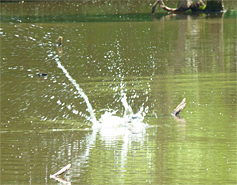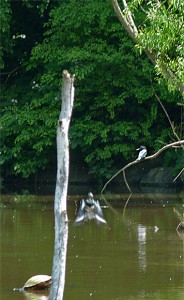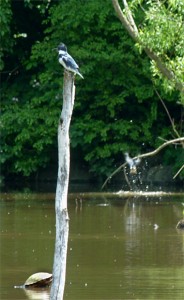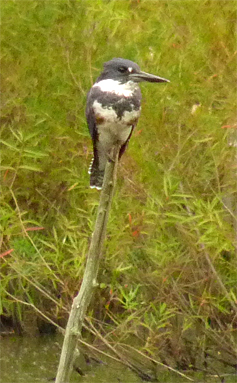
The picture on the right is of the splash made by an adult male Belted Kingfisher as it dove into the water. The kingfisher was demonstrating to its young fledglings how to catch fish.
I saw at least three kingfishers in the Wetlands on Wednesday (5/18). The next day it was reported that there were five of them there. Two of those were adults, the rest were the young of the year.

The appearance of the kingfishers with their young is eight days earlier than last year’s return to the Wetlands by the pair.
The adults spent the last four or five days showing the juveniles how to catch fish. The young birds perched over the water on exposed branches at various locations around the Wetlands while the adults crashed into the water, not necessarily catching fish but apparently demonstrating the process involved. I didn’t see the adult actually catch fish as I and the young birds looked on, but I did see the young kingfisher crash down into the water, imitating its parent.
Kingfishers are raucous creatures that don’t sit still for long, and for that reason are fun to watch. They are also wary. Most kingfishers that I’ve come across don’t allow a very close approach. Is this wariness a learned trait?

While I was photographing the birds that you see here, splashing around in the water of the Wetlands, one of the fledglings landed on the umbrella that I was standing under. This young bird obviously didn’t consider me a threat.
Even so, there must be something in a kingfisher’s genes that makes them more wary as they mature. I’m sure there are Belted Kingfishers out there that allow people to get relatively close to them as the birds perch by the water’s edge, but the vast majority of Belted Kingfishers that I’ve seen do not.
Our resident female certainly has nothing to fear in our Wetlands. No one harasses her or throws things at her. In fact, most folks don’t even know she exists as she sits out there on a willow branch.

Even with her almost constant rattle, and bobbing of her head and tail, most people pass right by the Wetlands without noticing her.
Next time you’re out on the boardwalk in Explore the Wild, keep an eye out for our kingfisher. Now that the nestlings have become fledglings, our female will be out and about more often. No more sitting on eggs, hurrying back and forth to the nest with fish to feed the nestlings…it won’t be long till our female’s on her own again.
Ranger Greg…will the adults and juvenile Kingfishers stay around the Museum wetlands for the rest of the summer? It is totally cool that the museum is a sanctuary for turtles, snakes, migrating birds, etc……
Time to renew my Museum membership..Thank you DJ
No, the juveniles and adult male won’t be around all summer. The male (a male) only shows up occasionally, more frequently in March each year during the mating season. The juveniles will probably be asked to leave soon. In fact they may have already moved to another location, perhaps following the male to his favorite fishing hole, maybe behind the KMart on Roxboro Road here in Durham (there’s a beaver pond back there) or some other local pond.
I did see two kingfishers out over the water yesterday (5/26), but I’m sure they’ll be out exploring other locations in the next few days and weeks.
Our Wetlands here at the Museum is essentially the female’s domain. She’ll be here the entire year.